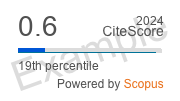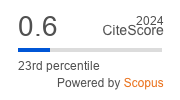Clinical, laboratory and instrumental correlations with the functional significance of coronary artery stenosis in patients with stable coronary artery disease and hypertension
https://doi.org/10.29001/2073-8552-2025-40-3-94-104
Abstract
Background. A significant proportion of patients with coronary artery disease (CAD) require myocardial revascularization. Arterial hypertension (AH), as a major risk factor for CAD, may influence the extent and severity of coronary artery (CA) lesions. However, visual assessment of coronary stenosis based on angiographic imaging does not always reflect their true hemodynamic significance. Therefore, the use of invasive functional assessment methods, such as the instantaneous wave-free ratio (iFR), is recommended for quantifying the ischemic potential of borderline stenosis. At present, there are no established clinical predictors for identifying functionally significant coronary lesions. Developing predictive models based on clinical, laboratory, and non-invasive imaging parameters may enhance decision-making regarding myocardial revascularization and the management of modifiable risk factors.
Aim: To evaluate the associations between the functional significance of CA stenosis and clinical, laboratory, blood pressure (BP), and epicardial adipose tissue (EAT) parameters in patients with stable CAD and HT.
Material and Methods. The study included 82 patients (56 men; mean age 66.1 ± 8.5 years) with stable CAD and HT, all of whom had borderline (50–90%) CA stenosis identified by coronary angiography. All participants underwent comprehensive clinical and laboratory assessment, transthoracic echocardiography, 24-hour ambulatory BP monitoring (ABPM), computed tomography (CT) for EAT volume and density evaluation, and iFR measurement to determine the functional significance of coronary stenosis.
Results. Patients were divided into two groups based on iFR values: those with functionally significant stenosis (iFR ≤ 0.89; n = 58) and those without (iFR > 0.89; n = 24). Both groups were comparable in baseline clinical and laboratory parameters. Patients with functionally significant stenosis demonstrated significantly higher clinical systolic BP (SBP), 24-hour SBP, and pulse pressure; greater daytime SBP load; reduced heart rate variability; a higher percentage of blood monocytes; lower prevalence of abdominal obesity; and smaller left atrial (LA) size. Multivariate logistic regression analysis, confirmed by ROC analysis, identified clinical SBP, monocyte percentage, and LA size as independent predictors of functionally significant stenosis.
Conclusion. In patients with stable CAD and HT, the presence of functionally significant CA stenosis is associated with elevated SBP, increased monocyte count, and smaller LA size.
Keywords
About the Authors
I. V. ZyubanovaRussian Federation
Irina V. Zyubanova - Cand. Sci. (Med.), Research Scientist, Hypertension Department, Cardiology Research Institute, Tomsk NRMC.
111 а, Kievskaya str., Tomsk, 634012
V. F. Mordovin
Russian Federation
Victor F. Mordovin - Dr. Sci. (Med.), Professor, Leading Research Scientist, Hypertension Department, Cardiology Research Institute, Tomsk NRMC.
111 а, Kievskaya str., Tomsk, 634012
V. A. Lichikaki
Russian Federation
Valeriya A. Lichikaki - Cand. Sci. (Med.), Research Scientist, Hypertension Department, Cardiology Research Institute, Tomsk NRMC.
111 а, Kievskaya str., Tomsk, 634012
M. A. Manukyan
Russian Federation
Musheg A. Manukyan - Cand. Sci. (Med.), Research Scientist, Hypertension Department, Cardiology Research Institute, Tomsk NRMC.
111 а, Kievskaya str., Tomsk, 634012
S. A. Khunkhinova
Russian Federation
Simzhit A. Khunkhinova - Research Scientist, Hypertension Department, Cardiology Research Institute, Tomsk NRMC.
111 а, Kievskaya str., Tomsk, 634012
S. E. Pekarsky
Russian Federation
Stanislav E. Pekarskiy - Dr. Sci. (Med.), Leading Research Scientist, Laboratory of X-ray Endovascular Surgery, Cardiology Research Institute, Tomsk NRMC.
111 а, Kievskaya str., Tomsk, 634012
A. E. Baev
Russian Federation
Andrey E. Baev - Cand. Sci. (Med.), Cardiologist, Head of Department of Invasive Cardiology, Cardiology Research Institute, Tomsk NRMC.
111 а, Kievskaya str., Tomsk, 634012
E. S. Gergert
Russian Federation
Egor S. Gergert - Head of the Department of X-ray Surgical Diagnostic and Treatment Methods, Cardiology Research Institute, Tomsk NRMC.
111 а, Kievskaya str., Tomsk, 634012
K. V. Zavadovsky
Russian Federation
Konstantin V. Zavadovsky - Dr. Sci. (Med.), Head of the Department of Radiation Diagnostics, Cardiology Research Institute, Tomsk NRMC.
111 а, Kievskaya str., Tomsk, 634012
N. I. Ryumshina
Russian Federation
Nadezhda I. Ryumshina - Cand. Sci. (Med.), Research Scientist, Department of Radiology and Tomography, Cardiology Research Institute, Tomsk NRMC.
111 а, Kievskaya str., Tomsk, 634012
N. S. Babich
Russian Federation
Nikita S. Babich - Research Assistant, Hypertension department, Cardiology Research Institute, Tomsk NRMC.
111 а, Kievskaya str., Tomsk, 634012
S. Ch. Sharakshanova
Russian Federation
Ajana Ch. Sharakshanova - Research Assistant, Hypertension department, Cardiology Research Institute, Tomsk NRMC.
111 а, Kievskaya str., Tomsk, 634012
N. A. Ustintsev
Russian Federation
Nikita A. Ustintsev - Fifth-year Student, Siberian State Medical University.
111 а, Kievskaya str., Tomsk, 634012
A. Yu. Falkovskaya
Russian Federation
Allа Yu. Falkovskaya - Dr. Sci. (Med.), Head of the Hypertension Department, Cardiology Research Institute, Tomsk NRMC.
111 а, Kievskaya str., Tomsk, 634012
References
1. Mordovin V.F., Lichikaki V.A., Pekarsky S.E., Zyubanova I.V., Manukyan M.A., Solonskaya E.I. et al. Functional significance of coronary artery stenosis: the role of arterial hypertension (literature review). Siberian Journal of Clinical and Experimental Medicine. 2024;39(4):10–17. (In Russ.). https://doi.org/10.29001/2073-8552-2024-39-4-10-17.
2. Tonino P.A., De Bruyne B., Pijls N.H., Siebert U., Ikeno F., van' t Veer M. et al. FAME Study Investigators. Fractional flow reserve versus angiography for guiding percutaneous coronary intervention. N. Engl. J. Med. 2009;360(3):213–224. https://doi.org/10.1056/NEJMoa0807611.
3. Fogelson B., Tahir H., Livesay J., Baljepally R. Pathophysiological factors contributing to fractional flow reserve and instantaneous wavefree ratio discordance. Rev. Cardiovasc. Med. 2022;23(2):70. https://doi.org/10.31083/j.rcm2302070.
4. Golukhova E.Z., Petrosian K.V., Abrosimov A.V., Bulaeva N.I., Goncharova E.S., Berdibekov B.Sh. Impact of assessment of fractional flow reserve and instantaneous wave-free ratio on clinical outcomes of percutaneous coronary intervention: a systematic review, metaanalysis and meta-regression analysis. Russian Journal of Cardiology. 2023;28(1S):5325. (In Russ.). https://doi.org/10.15829/1560-40712023-5325.
5. Grundmann S., Piek J.J., Pasterkamp G., Hoefer I.E. Arteriogenesis: basic mechanisms and therapeutic stimulation. Eur. J. Clin. Invest. 2007;37(10):755–766. https://doi.org/10.1111/j.1365-2362.2007.01861.x
6. Aktan A., Güzel T., Özbek M., Demir M., Kılıç R., Arslan B., Aslan B. The relationship between coronary collateral circulation and visceral fat. e-Journal of Cardiovascular Medicine. 2021;9(1):27–38. https://doi.org/10.32596/ejcm.galenos.2021-01-05.
7. Ansari M.A., Mohebati M., Poursadegh F., Foroughian M., Shamloo A.S. Is echocardiographic epicardial fat thickness increased in patients with coronary artery disease? A systematic review and meta-analysis. Electron Physician. 2018;10(9):7249–7258. https://doi.org/10.19082/7249.
8. Pei J., Wang X., Xing Z. Traditional cardiovascular risk factors and coronary collateral circulation: A meta-analysis. Front. Cardiovasc. Med. 2021;8:743234. https://doi.org/10.3389/fcvm.2021.743234.
9. Börekçi A., Gür M., Şeker T., Baykan A.O., Özaltun B., Karakoyun S. et al. Coronary collateral circulation in patients with chronic coronary total occlusion; its relationship with cardiac risk markers and SYNTAX score. Perfusion. 2015;30(6):457–464. https://doi.org/10.1177/0267659114558287.
10. Neglia D., Liga R., Gimelli A., Podlesnikar T., Cvijić M., Pontone G. et al. EURECA Investigators. Use of cardiac imaging in chronic coronary syndromes: the EURECA Imaging registry. Eur. Heart J. 2023;44(2):142– 158. https://doi.org/10.1093/eurheartj/ehac640.
11. Stanton T., Dunn F.G. Hypertension, left ventricular hypertrophy, and myocardial ischemia. Med. Clin. North. Am. 2017;101(1):29–41. https://doi.org/10.1016/j.mcna.2016.08.003.
12. Kayapinar O., Ozde C., Aktüre G., Coşkun G., Kaya A. Effect of systemic arterial blood pressure on fractional flow reserve. J. Cardiovasc. Dis. Diagn. 2021;9(7):462. URL: https://www.hilarispublisher.com/openaccess/effect-of-systemic-arterial-blood-pressure-on-fractional-flowreserve.pdf (15.08.2025).
13. Yılmaz C., Güvendi Şengör B., Karaduman A. et al. Association of wide pulse pressure with coronary collateral flow in patients with ST-elevation myocardial infarction undergoing percutaneous coronary intervention. J. Hum. Hypertens. 2025;(39):210–216. https://doi.org/10.1038/s41371024-00986-3.
14. Emlek N., Özyıldız A.G., Ergül E., Öğütveren M.M., Öztürk M., Aydın C. The association of new atherosclerosis markers with coronary collaterals in chronic total occlusion patients. Cardiovasc. Surg. Int. 2022;9(3):152–158. http://dx.doi.org/10.5606/e-cvsi.2022.1368.
15. Kyriakides Z.S., Kremastinos D.T., Michelakakis N.A., Matsakas E.P., Demovelis T., Toutouzas P.K. Coronary collateral circulation in coronary artery disease and systemic hypertension. J. Am. Coll. Cardiol. 1991;67(8):687–690. https://doi.org/10.1016/00029149(91)90522-M.
16. Sara J.D., Widmer R.J., Matsuzawa Y., Lennon R.J., Lerman L.O., Lerman A. Prevalence of coronary microvascular dysfunction among patients with chest pain and nonobstructive coronary artery disease. JACC Cardiovasc. Interv. 2015;8(11):1445–1453. https://doi.org/10.1016/j.jcin.2015.06.017.
17. Aljizeeri A., Gin K., Barnes M.E., Lee P.K., Nair P., Jue J. et al. Atrial remodeling in newly diagnosed drug-naive hypertensive subjects. Echocardiography. 2013;30(6):627–633. https://doi.org/10.1111/echo.12119.
18. Stritzke J., Markus M.R., Duderstadt S., Lieb W., Luchner A., Döring A. et al. MONICA/KORA Investigators. The aging process of the heart: obesity is the main risk factor for left atrial enlargement during aging the MONICA/KORA (monitoring of trends and determinations in cardiovascular disease/cooperative research in the region of Augsburg) study. J. Am. Coll. Cardiol. 2009;54(21):1982–1989. https://doi.org/10.1016/j.jacc.2009.07.034.
19. Fang Z., Raza U., Song J., Lu J., Yao S., Liu X. et al. Systemic aging fuels heart failure: Molecular mechanisms and therapeutic avenues. ESC Heart Fail. 2025;12(2):1059–1080. https://doi.org/10.1002/ehf2.14947.
Review
For citations:
Zyubanova I.V., Mordovin V.F., Lichikaki V.A., Manukyan M.A., Khunkhinova S.A., Pekarsky S.E., Baev A.E., Gergert E.S., Zavadovsky K.V., Ryumshina N.I., Babich N.S., Sharakshanova S.Ch., Ustintsev N.A., Falkovskaya A.Yu. Clinical, laboratory and instrumental correlations with the functional significance of coronary artery stenosis in patients with stable coronary artery disease and hypertension. Siberian Journal of Clinical and Experimental Medicine. 2025;40(3):94-104. (In Russ.) https://doi.org/10.29001/2073-8552-2025-40-3-94-104





.png)





























